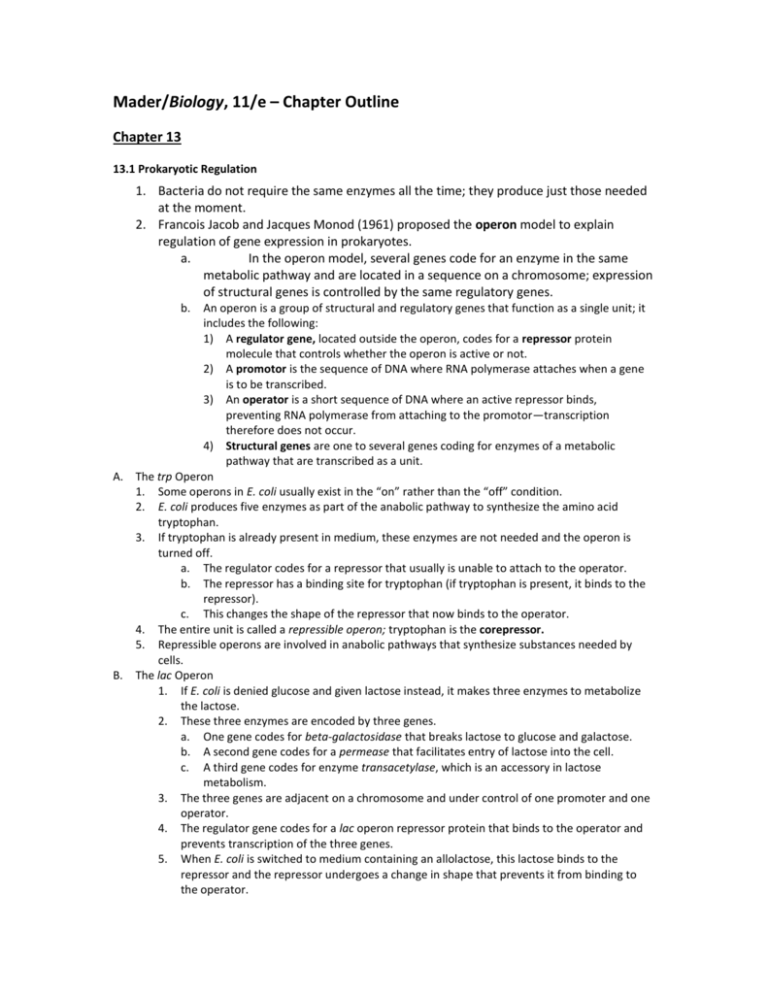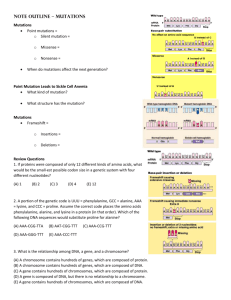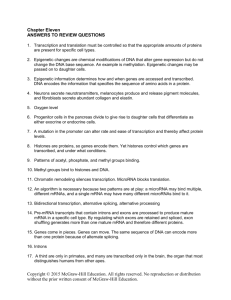Mader/Biology, 13/e – Chapter Outline
advertisement

Mader/Biology, 11/e – Chapter Outline Chapter 13 13.1 Prokaryotic Regulation 1. Bacteria do not require the same enzymes all the time; they produce just those needed at the moment. 2. Francois Jacob and Jacques Monod (1961) proposed the operon model to explain regulation of gene expression in prokaryotes. a. In the operon model, several genes code for an enzyme in the same metabolic pathway and are located in a sequence on a chromosome; expression of structural genes is controlled by the same regulatory genes. b. An operon is a group of structural and regulatory genes that function as a single unit; it includes the following: 1) A regulator gene, located outside the operon, codes for a repressor protein molecule that controls whether the operon is active or not. 2) A promotor is the sequence of DNA where RNA polymerase attaches when a gene is to be transcribed. 3) An operator is a short sequence of DNA where an active repressor binds, preventing RNA polymerase from attaching to the promotor—transcription therefore does not occur. 4) Structural genes are one to several genes coding for enzymes of a metabolic pathway that are transcribed as a unit. A. The trp Operon 1. Some operons in E. coli usually exist in the “on” rather than the “off” condition. 2. E. coli produces five enzymes as part of the anabolic pathway to synthesize the amino acid tryptophan. 3. If tryptophan is already present in medium, these enzymes are not needed and the operon is turned off. a. The regulator codes for a repressor that usually is unable to attach to the operator. b. The repressor has a binding site for tryptophan (if tryptophan is present, it binds to the repressor). c. This changes the shape of the repressor that now binds to the operator. 4. The entire unit is called a repressible operon; tryptophan is the corepressor. 5. Repressible operons are involved in anabolic pathways that synthesize substances needed by cells. B. The lac Operon 1. If E. coli is denied glucose and given lactose instead, it makes three enzymes to metabolize the lactose. 2. These three enzymes are encoded by three genes. a. One gene codes for beta-galactosidase that breaks lactose to glucose and galactose. b. A second gene codes for a permease that facilitates entry of lactose into the cell. c. A third gene codes for enzyme transacetylase, which is an accessory in lactose metabolism. 3. The three genes are adjacent on a chromosome and under control of one promoter and one operator. 4. The regulator gene codes for a lac operon repressor protein that binds to the operator and prevents transcription of the three genes. 5. When E. coli is switched to medium containing an allolactose, this lactose binds to the repressor and the repressor undergoes a change in shape that prevents it from binding to the operator. 6. C. Because the repressor is unable to bind to the operator, the promoter is able to bind to RNA polymerase, which carries out transcription and produces the three enzymes. 7. An inducer is any substance (lactose in the case of the lac operon) that can bind to a particular repressor protein, preventing the repressor from binding to a particular operator; consequently, RNA polymerase can bind to the promoter and transcribe the structural genes. Further Control of the lac Operon 1. Since E. coli prefers to break down glucose, how does E. coli know how to turn on when glucose is absent? 2. When glucose is absent, cyclic AMP (cAMP) accumulates; cAMP has only one phosphate group and attaches to ribose at two locations. a. CAP is a catabolite activator protein (CAP) in the cytoplasm. b. When cAMP binds to CAP, the complex attaches to a CAP binding site next to the lac promoter. c. When CAP binds to DNA, DNA bends, exposing the promoter to RNA polymerase. d. Only then does RNA polymerase bind to the promoter; this allows expression of the lac operon structural genes. 3. When glucose is present, there is little cAMP in the cell. a. CAP is inactive and the lactose operon does not function maximally. b. CAP affects other operons when glucose is absent. c. This encourages metabolism of lactose and provides a backup system for when glucose is absent. 4. Active repressors shut down the activity of an operon—this is negative control. 5. CAP is an example of positive control; when the molecule is active, it promotes the activity of the operon. 6. Use of both positive and negative controls allows the cell to fine-tune control of its metabolism. 7. If both glucose and lactose are present, the cell preferentially metabolizes glucose. 13.2 Eukaryotic Regulation 1. 2. 3. Different cells in the human body turn on different genes that code for different protein products. Eukaryotes have four levels of regulatory mechanisms to control gene expression; two in the nucleus and two in the cytoplasm. There are several levels of control that can modify the amount of gene product. a. Chromatin structure: if genes are not accessible to RNA polymerase, they cannot be transcribed. 1) Chromatin structure is part of epigenetic inheritance, the transmission of genetic information outside the coding sequences of a gene. b. Transcriptional control in the nucleus determines which structural genes are transcribed and the rate of transcription; it includes transcription factors initiating transcription and transposons (DNA sequences that move between chromosomes and shut down genes). c. Posttranscriptional control occurs in the nucleus after DNA is transcribed and preliminary mRNA forms. 1) This may involve differential processing of mRNA before it leaves the nucleus. 2) The speed that mature mRNA leaves nucleus affects the ultimate amount of gene product. d. Translational control occurs in cytoplasm after mRNA leaves the nucleus but before there is a protein product. 1) The life expectancy of mRNA molecules can vary, as well as their ability to bind ribosomes. 2) Some mRNAs may need additional changes before they are translated at all. e. Posttranslational control occurs in the cytoplasm after protein synthesis. 1) Polypeptide products may undergo additional changes before they are biologically functional. 2) A functional enzyme is subject to feedback control; binding of an end product can change the shape of an enzyme so it no longer carries out its reaction. A. Chromatin Structure 1. Eukaryotic DNA is in the form of chromatin, a stringy material associated with proteins. 2. During interphase, some chromatin is highly compact, darkly stained, and genetically inactive heterochromatin. 3. Euchromatin activity is related to the extent nucleosomes are coiled and condensed. a. A nucleosome is a bead-like unit made of a segment of DNA wound around a complex of histone proteins. b. When DNA is transcribed, activators called remodeling proteins are able to push aside the histone proteins so transcription can begin. 4. Barr bodies are an example of heterochromatin. a. Since human males have only one X chromosome, it might be supposed that they produce half the gene product of a female with two X chromosomes. b. However, females have in each nucleated cell a darkly staining Barr body, a condensed, inactive X chromosome. c. Which X chromosome is condensed in each cell is determined by chance. d. Thus, the body of heterozygous females is “mosaic”; half her cells express alleles on one X chromosome and half of her cells express the alleles on the other X chromosome. e. Female gonads do not show Barr bodies; both X chromosomes are needed in development. f. Only one active X chromosome in the female zygote means that lower X-coded gene products are normal. g. Other examples of this mosaic effect include: ocular albinism, Duchenne muscular dystrophy, and female calico cat coat color. 5. Epigenetic inheritance is the term used to describe inheritance patterns that do not depend on the genes themselves. a. Histones proteins have different chemical modifications in heterochromatin and euchromatin. b. Methylation of DNA accounts for a phenomenon called genomic imprinting: gene expression is dependent on whether the chromosome carrying the gene is inherited from the mother or the father. c. Epigenetic inheritance explains unusual inheritance patterns, and may have implications in growth, aging, and cancer. B. Transcriptional Control 1. Transcriptional control is the most critical level of genetic control. a. Transcription is controlled by DNA-binding proteins called transcription factors. b. Each cell contains many different types of transcription factors. c. A group of transcription factors binds to a promoter adjacent to a gene; the complex attracts and binds RNA polymerase, but transcription may still not begin. d. Transcription activators are often involved in controlling transcription in eukaryotes. 1) Different combinations may regulate different genes. 2) Transcription activators bind to DNA regions called enhancers. 3) Enhancers can be quite a distance from the promoter, but a hairpin loop in the DNA brings the activator attached to an enhancer into contact with the promotor. 4) Mediator proteins act as a bridge between transcription factors and transcription factors at the promotor. e. Transcription factors are always present in the cell and most likely they have to be activated in some way (e.g., regulatory pathways involving kinases or phosphatases) before they bind to DNA. C. Posttranscriptional Control 1. Posttranscriptional control includes mRNA processing and the speed at which mRNA leaves the nucleus. 2. Messenger RNA molecules are processed before they leave the nucleus and enter the cytoplasm. 3. Differential excision of introns and splicing of mRNA can vary the type of mRNA that leaves nucleus. a. The hypothalamus and thyroid glands produce calcitonin but the mRNA that leaves the nucleus is not the same in both types of cells. b. Evidence of different patterns of mRNA splicing is found in cells that produce neurotransmitters, muscle regulatory proteins, and antibodies. 4. Speed of transport of mRNA from nucleus into cytoplasm affects the amount of gene product realized per unit time following transcription; there is a difference in the length of time it takes various mRNA molecules to pass through nuclear pores. 5. The DNA that is not transcribed into a protein is used to form small RNA (sRNA) molecules and regulate gene expression by: a. Alter DNA compaction so some genes are inaccessible to the transcription machinery of the cell. b. microRNAs (miRNAs) can bind to mRNA and slow down or stop translation in the cytoplasm. c. Small interfacing RNAs (siRNAs) forms an active silencing complex that breaks down specific mRNAs and prevents them from being expressed. D. Translational Control 1. Translational control begins when the processed mRNA molecule reaches the cytoplasm and before there is a protein product. a. The longer an active mRNA molecule remains in the cytoplasm, the more product is produced. b. Mature red blood cells eject their nucleus but synthesize hemoglobin for several months; the mRNAs must persist during this time. c. Ribonucleases are enzymes associated with ribosomes that degrade mRNA. d. Mature mRNA has non-coding segments at 3' cap and 5' poly-A tail ends; differences in these segments influence how long the mRNA avoids being degraded. e. MicroRNAs are small, processed pieces of intron; after microRNAs are degraded, they combine with protein and the complex binds to mRNAs, destroying them. E. Posttranslational Control 1. Posttranslational control begins once a protein has been synthesized and has become active. a. Some proteins are not active after synthesis; the polypeptide product has to undergo additional changes before it is biologically functional. b. Bovine proinsulin, for example, is inactive when first produced; a single long polypeptide folds into a three-dimensional structure, a sequence of 30 amino acids is removed from the middle, and the two polypeptide chains are bonded together by disulfide bonds resulting in an active protein. c. Many proteins are short-lived in cells and degraded or destroyed by enzymes called proteases so they are no longer active. d. Proteases are confined to special structures called proteasomes. e. One example is the cyclins that control the cell cycle; they are only temporarily present. F. Alternative mRNA Splicing in Disease (Nature of Science reading) 1. Gorlin syndrome is an autosomal dominant disease that causes an aggressive type of skin cancer. a. It is linked to the tumor suppressor gene, patched, which is found on chromosome 9. b. It was previously thought that patched mutations occurred within the gene’s exons, but current research demonstrated these mutations occur within the gene’s introns. c. The mutations caused mRNA to be incorrectly spliced and then making the proteins nonfunctional. Spinal muscular dystrophy (SMD) is also caused by defective pre-mRNA splicing. a. Exon 7 of the SMN2 gene is omitted from the mature mRNA in SMA patients, making the protein nonfunctional. b. SMA results in loss of spinal cord motor neurons, paralysis and skeletal muscle atrophy. c. Scientists are working with a new technique, antisense oligonucleotide technology, to reverse the effects of the disorder. d. The results support that targeting pre-mRNA splicing may be a tangible treatment for many of these disorders. 3. Scientist are using pre-mRNA splicing to design more powerful medicine with less side effects, as well as new therapy that may be more effective in battling many disorders. 13.3 Gene Mutations 2. 1. A gene mutation is a permanent change in the sequence of bases in DNA; mutations range from having no effect to total inactivity. A. Causes of Mutations 1. Spontaneous mutations result in abnormalities in normal biological processes. a. Mutations due to replication errors are very rare. b. DNA polymerase constantly proofreads new DNA against the old, and repairs any irregularities, thereby reducing mistakes to one out of every one billion nucleotide pairs replicated. 2. Induced mutations are changes in the DNA base sequencing from exposure to toxic chemicals or radiation. a. Carcinogens are mutagens that increase the chances of cancer. 1) The Ames test is commonly used to determine if a chemical is carcinogenic. 2) A histidine-requiring strain of bacteria is exposed to a chemical. 3) If the chemical is mutagenic, the bacteria regain the ability to grow without histidine. b. Tobacco smoke contains a number of known carcinogenic chemicals. c. X rays and gamma rays are ionizing radiation that creates free radicals, ionized atoms with unpaired electrons. d. Ultraviolet (UV) radiation is easily absorbed by pyrimidines in DNA. 1) Where two thymine molecules are near each other, UV may bond them together as thymine dimers. 2) Usually dimers are removed from damaged DNA by special enzymes called DNA repair enzymes. B. Effect of Mutations on Protein Activity 1. Point mutations change a single nucleotide and therefore change a single specific codon. a. The effect of the point mutation depends on the specific base change in the codon. b. Changes to codons that code for the same amino acid have no effect; e.g., UAU to UAC both code for tyrosine. c. A change from UAC to UAG (a stop codon) results in a shorter protein, and a change from UAC to CAC incorporate histidine instead of tyrosine. d. Sickle cell disease results from a single base change in DNA where the beta-chain of hemoglobin contains valine instead of glutamate at one location and the resulting distorted hemoglobin causes red blood cells to clog vessels and die off sooner. 2. Frameshift Mutations occur most often when one or more nucleotides are either inserted or deleted from DNA. a. The reading frame depends on the sequence of codons from the starting point: THE CAT ATE THE RAT. b. If, for example, C is deleted, the reading frame is shifted: THE ATA TET HER AT. c. Frameshift mutations occur when one or more nucleotides are inserted or deleted from DNA. d. The result of a frameshift mutation is a new sequence of codons and nonfunctional proteins. A single nonfunctional protein can cause dramatic effects. a. The human transposon Alu is responsible for hemophilia when it places a premature stop codon in the gene for clotting factor IX. b. PKU results when a person cannot convert phenylalanine to tyrosine; phenylalanine builds up in the system, leading to mental retardation. c. A faulty code for an enzyme in the same pathway results in an albino individual. d. Cystic fibrosis is due to inheriting a faulty code for a chloride transport protein in the plasma membrane. e. Androgen insensitivity is due to a faulty receptor for male sex hormones; body cells cannot respond to testosterone and the individual develops as a female (even though all of the body cells are XY). Mutations Can Cause Cancer 1. The development of cancer involves a series of various types of mutations. 2. Tumor-suppressor genes normally act as brakes on cell division when it begins to occur abnormally. 3. When proto-oncogenes mutate, they become oncogenes. 4. Tumor-suppressor genes and proto-oncogenes often code for transcription factors or proteins that control transcription factors. 5. P53, a major tumor-suppressor gene, is more frequently mutated in human cancers than any other known gene. a. The p53 protein acts as a transcription factor to turn on the expression of genes whose products are cell cycle inhibitors. b. The p53 can also stimulate apoptosis (programmed cell death). 6. Other proto-oncogenes code for Ras proteins, which are needed for normal cell growth and DNA synthesis. 3. C.








